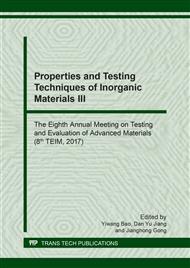p.92
p.97
p.102
p.109
p.114
p.119
p.129
p.135
p.140
Application of Reduced Graphene Oxide and Graphene Quantum Dots in PTB7:PC71BM Polymer Solar Cells
Abstract:
Graphene has many advantages such as high optical transmittance, low resistance, adjustable work function and stable physical and chemical properties. Graphene quantum dots (GQDs) have unique optical properties and excellent electronic conductivity. GQDs can effectively prolong the lifetime of carriers and increase the quantum yield. In this study, reduced graphene oxide (RGO) solution was prepared by ultrasonic method, and GQDs were prepared by one-step hydrothermal reaction which used graphene oxide slurry as raw material. The particle size of GQDs is 8~10 nm. Incorporation of RGO and GQDs into the active layer or the electron transport layer (ETL) resulted in good efficiency enhancement of the performance of ZnO-based inverted PTB7:PC71BM polymer solar cells (PSCs). The photoelectric conversion efficiency (PCE) of the PSCs is up to 3.89% when the doping amount of RGO is 10 wt. %. Addition of GQDs to active layer resulted in 8% efficiency enhancement from 3.20% to 3.46%. Addition of GQDs to ZnO ETL led to a more remarkable 25% efficiency enhancement, and PCE reached 4.02%. The Au NPs and GQDs co-doping in ZnO ETL caused a synergistic effect in improving the photovoltaic performance, producing a PCE of 4.23%, which is a 32.19% enhancement with respect to a pure ZnO ETL based device.
Info:
Periodical:
Pages:
114-118
Citation:
Online since:
April 2018
Authors:
Keywords:
Price:
Сopyright:
© 2018 Trans Tech Publications Ltd. All Rights Reserved
Share:
Citation:


